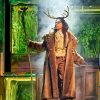The fascination of the miniature
As a child I was mesmerized by the models in the departments of Egyptian museums; the beautiful model boats that would take the soul of a dead king to the stars; the bakers who would make his bread for the journey etc. Other artifacts, from later eras, such as a mechanical tiger eating a man that doubled as a hurdy-gurdy also appealed, as did fantastic early clocks with their workings proudly displayed. All these influences helped to encourage a fascination for making things, creating imaginary worlds and planning for impossible Heath Robinsonesque machines.
In my case, an obsession with tree houses and puppet theatres turned, at university, into the construction of full-scale theatre sets. I had, at that stage, no formal training and didn’t realize that you were meant to make models before embarking on the full scale build. I worked from sketches, lists of timber lengths and what could be found or recycled from skips. All assembled in 72 hours without sleep and gleefully knocked down again at the end of a week.
At postgraduate design school, I began to appreciate the value of model making. However, I hope I have never forgotten the lessons of working with real materials; appreciating the textures, scale and weight of real stuff, how the world you create relates to the scale of the human form; the exciting possibilities of using found objects in a sculptural way to create a world. A realization too, of how long and how many people it takes to ‘just change that…’ The model allows you the space to experiment, to make mistakes before your ideas become too concrete and public.
Working in Europe has shown me that there is no one fixed way of designing for theatre. The Germans have a superb system called a Bauprobe, where the ideas from initial rough models are mocked-up with stock flats and timber in the space; this allows you to adjust scale and form in the actual, to view the design from every possible seat. (This is now possible in a virtual way too with 3D modeling) What in a model would have been barely noticeable, a change of height, say 10cm, can have a huge effect on the action. At the RSC (Royal Shakespeare Company) I managed something similar on Romeo and Juliet, adjusting the height of a wall so that the lovers were just able to touch finger tips in the balcony scene. We worked out heights using step ladders and string! That knowledge was then taken back to the model and informed all subsequent development.
I was luckily able to assist Chloe Obolensky on Peter Brooks’ production of the Tempest. We worked for about a month on a model of the Bouffe du Nord inParis, exploring different ways of reinventing this beautiful ‘Empty Space’. Throughout, the head painter Ulysses worked along side us. He was exploring the way Chloe applied texture and colour and then mixed glazes that were then the basis for the work in the theatre itself. Once we moved into the theatre, the model was rapidly set aside as Chloe worked on what was in front of her. The function of the model had been, to explore a process of working and to allow the creative team to build up a shared language of expression.
The architect Frank Gehry (of Guggenheim Bilbao fame) uses model making in a wonderfully free and sculptural way. Using silver paper, scissors and tape he and his team rapidly create sketch models, which they photograph, discard as the search moves on. Only once he is truly satisfied is a refined model made and scanned used the latest 3-D scanner technology. A fine example of how to integrate the necessity of rapid exploration with knowing when is the right time to look at detail and use the power of computers to render the space.
In Britain, we tend to have far shorter preparation and rehearsal times, and there is rarely the luxury of building a team in the way Chloe did, so the model; has by necessity become a more crucial means of communication. Designers work as freelancers with many jobs on the go and are not always on hand to answer every query from the production workshops. It is for that reason that we have developed into the world leaders in terms of the finesse of our model making. The delivered model often gives a theatre all the information they need to create the show. So beware, because unless a good relationship is built-up with your workshop team (who understand what is meant to be followed slavishly, and what is a suggestion or an idea in development) what you put in the model will be what you see on stage; every mistake blown up x 25! There is an important balance to be found, which allows the model to inspire the creativity of fellow craftsmen, rather than instructing them exactly how to do everything, but they will need guidance, debate, references and drawings,. They will have to understand how the model fits into your way of working.
A model, in my view, is one of many tools that can be used as a means of expression, yet it should never become fixed. It is a way to explore ideas rapidly, to act as the focus of engagement between director and designer, but, it should never become a holy relic; untouchable because of the hours of labour that have gone into it; or the seductive beauty of its miniature world. What matters is what is on stage, the experience the audience has of the world of the play that your work has helped to evoke. At that point, the model becomes redundant and ends up in a dusty heap on some carpenters bench. Its work has been done, it is the production that matters and not how good the model was.
originally written as forward to Keith Orton’s book on model making









Leave a Comment